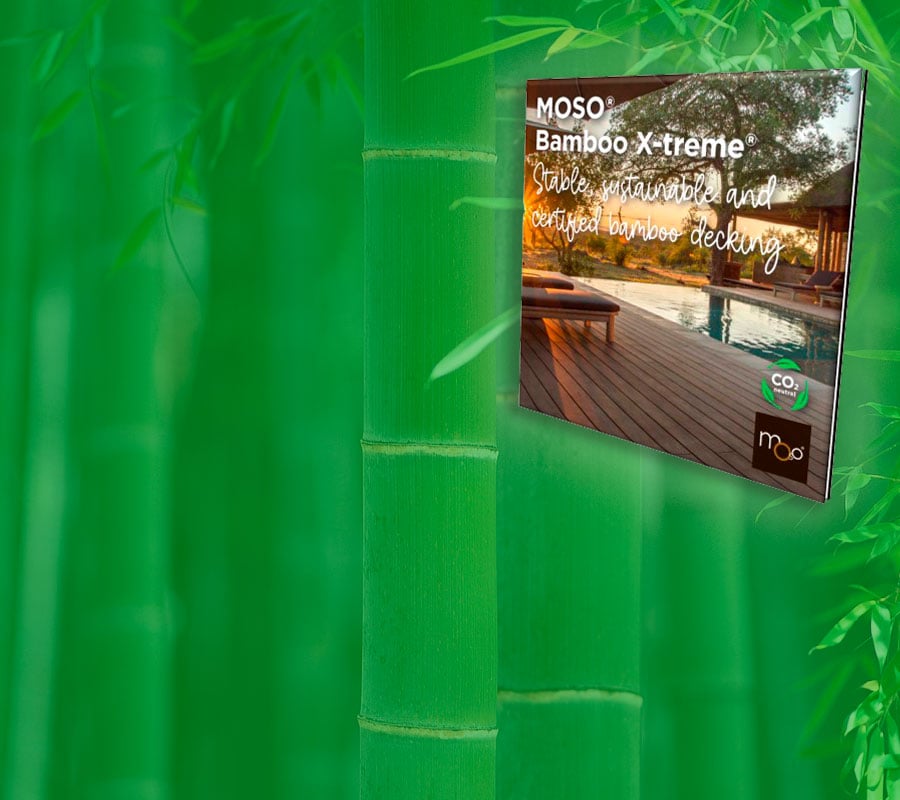Bamboo is a sustainable material that can be incorporated in various different elements of your project, including the deck. Whether bamboo decking is more sustainable than other materials is dependent on whether we are comparing natural or (semi)synthetic or “alternative” decking. When looking at synthetic decking materials, bamboo is a more sustainable option due to the use of a fast growing renewable resource and, in many cases, a less intense production process. However, when looking at fellow natural decking materials, this is generally on a par, depending on sourcing, production and the material / wood type used.
Are you more interested in bamboo decking compared to hardwood decking? Read this bamboo decking vs. hardwood decking blog.
How can bamboo decking be more sustainable compared to other decking materials?
- During the growth of bamboo, it captures loads of CO2 from the atmosphere and locks it into the material, like wood does in lower quantities, and synthetic or alternative decking materials don’t do at all.
- Thanks to its hardness and stability, a sustainable bamboo decking has an expected lifetime of over 25 years, which is often more than wooden decking, but stone and synthetic alternatives might have a longer lifetime.
- When the decking is no longer needed, bamboo can be re-used or recycled like wood, in the worst scenario being used as biomass energy, while synthetic alternatives are more difficult to recycle.
Read more about Bamboo X-treme® Decking here.
Synthetic or “alternative” decking
Within this category we find several different material types, some more sustainable than others. To generalise some more, find the following materials and learn more about their sustainable aspects.
PVC (polyvinylchloride) decking
These decking materials are made of pure oil based plastic, one of the most common plastics in the world. In many cases PVC decking is discussed as recycled or recyclable, but in general we are all aware of the current “plastic soup” disaster and the dangers of plastic for our environment. Granted, a decking is something that isn’t single use, however, it does have an expiration date and when that time comes, unless there are huge breakthroughs in the recycling industry, in many cases this will fill our landfills. Though many manufacturers state PVC decking can be replaced and reused, given it is resistant and pretty tough, PVC is prone to warping, discolouration, mould and general wear and tear in which, after the end of life, it cannot be sanded down and reused like other natural materials.
WPC (wood plastic composite) decking
Though WPC sounds like the better option in terms of sustainability with the use of “recycled” or repurposed wood, this is not the case. Described by William McDonough (Cradle to Cradle expert) as a “monstrous hybrid”, the hybrid material created by combining wood and plastic can no longer be recycled, nor further utilised. The separate elements, mainly wood and plastic, when separate, can be dealt with in a more sustainable way at the end of life. However, when merged and the new hybrid material is created, this is no longer possible to separate and is even more of a threat to the circular economy.
Metal decking
This decking material is very energy intensive when looking at the production process. Although most metals can be melted down and recycled, as with plastic, a certain percentage of virgin material is needed in order to create a strong product. This means that the initial metal, as well as the end product, will ultimately, at the end of its life, not be fully recycled as this is more difficult than natural materials such as sustainable bamboo decking.
Stone tiles
Of the options mentioned, tiles would be the most sustainable decking alterative when looking at “alternative” materials and what to use. The production process is generally rather energy intensive and many steps are involved, including vastly disfavoured quarrying. Tiles, however, may not necessarily be a good decking alternative for some projects, as they are extremely heavy, cannot be attached to sub beams like sustainable bamboo decking and mean extra attention must be paid to the foundation. At the same time, tiles do not offer the same flexibility in terms of design as wood or bamboo decking do.
Is bamboo decking the more sustainable option?
When compared to synthetic decking alternatives, bamboo is the most sustainable choice for several reasons. In terms of recycling and CO2-footprint, PVC and WPC are not sustainable. Though durable and relatively maintenance free, any damage that does occur cannot be fixed by sanding like natural decking and planks are often replaced. The replaced plank, as with the whole deck after it needs replacing, cannot be recycled and will ultimately fill landfills, an issue in which more attention needs to be paid to. In a world in which we avoid single use plastic, when will we reach the point in which large scale plastic products are also avoided for the same landfill crisis?
Do you want to know more about bamboo vs other decking materials? See the comparison page in which MOSO® Bamboo X-treme® is compared to the most common decking materials.






.png?width=2240&name=HubSpot%20Blog%20image%20%20(3).png)





%20Picture%20by%20Tim%20Baynham%20-1.jpg?width=600&height=300&name=2021006%20LR%20(20)%20Picture%20by%20Tim%20Baynham%20-1.jpg)
